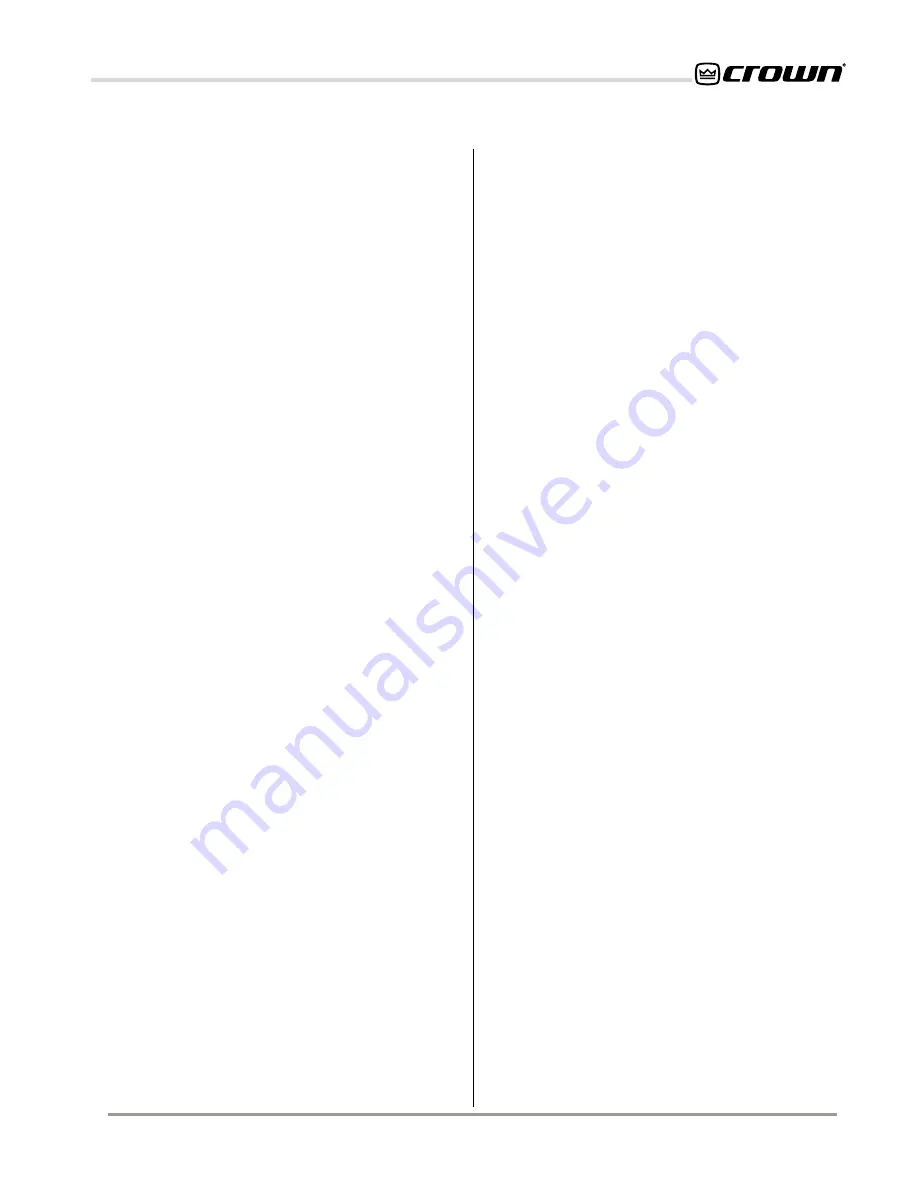
Page 15
Reference Manual
Macro-Tech
®
24x6 & 36x12 Power Amplifiers
1. Note the load resistance of the loudspeakers
connected to each channel of the amplifier. Mark
this value on the
Load Resistance
line of the no-
mograph.
2. Select an acceptable damping factor and mark it
on the
Damping Factor
line. Your amplifier can
provide an excellent damping factor of 1,000
from 10 to 400 Hz in Stereo mode with an 8-ohm
load. In contrast, typical damping factors are 50
or lower. Higher damping factors yield lower dis-
tortion and greater motion control over the loud-
speakers. A common damping factor for
commercial applications is between 50 and 100.
Higher damping factors may be desirable for
live sound, but long cable lengths often limit the
highest damping factor that can be achieved
practically. (Under these circumstances,
Crown’s
IQ System
®
is often used so amplifiers
can be monitored and controlled when they are
located very near the loudspeakers.) In record-
ing studios and home hi-fi, a damping factor of
500 or more is very desirable.
3. Draw a line through the two points with a pencil,
and continue until it intersects the
Source Resis-
tance
line.
4. On the
2-Cond. Cable
line, mark the length of
the cable run.
5. Draw a pencil line from the mark on the
Source
Resistance
line through the mark on the
2-
Cond. Cable
line, and on to intersect the
An-
nealed Copper Wire
line.
6. The required wire gauge for the selected wire
length and damping factor is the value on the
Annealed Copper Wire
line.
Note: Wire size in-
creases as the AWG value becomes smaller.
7. If the size of the cable exceeds what you want to
use, (1) find a way to use shorter cables, like us-
ing the
IQ System, (2) settle for a lower damping
factor, or (3) use more than one cable for each
line. Options 1 and 2 will require the substitution
of new values for cable length or damping factor
in the nomograph. For option 3, estimate the ef-
fective wire gauge by subtracting 3 from the ap-
parent wire gauge every time the number of
conductors of equal gauge is doubled. So, if #10
wire is too large, two #13 wires can be substi-
tuted, or four #16 wires can be used for the same
effect.
SOLVING OUTPUT PROBLEMS
Sometimes
high frequency oscillations
occur that can
cause your amplifier to prematurely activate its protec-
tion circuitry which can result in inefficient operation.
The effects of this problem are similar to the effects of
the RF interference described in Section 3.3.1. To pre-
vent high frequency oscillations from occurring:
1. Lace the loudspeaker conductors together. (Do
NOT lace cables together from different amplifi-
ers.) This minimizes the chance of them acting
like an antenna to transmit or receive high fre-
quencies that can cause oscillation.
2. Avoid using shielded loudspeaker cable.
3. Avoid long cable runs where the loudspeaker
cables from different amplifiers share a common
cable tray or jacket.
4. Never connect the amplifier’s input and output
grounds together.
5. Never tie the outputs of multiple amplifiers to-
gether.
6. Keep loudspeaker cables separated from input
cables.
7. Install a low-pass filter on each input line (similar
to the RF filters described in Section 3.3.1).
8. Install the input wiring according to the instruc-
tions in Section 3.3.1.
Another problem to avoid is the presence of large
sub-
sonic currents
when primarily inductive loads are
used. Examples of inductive loads are 70-volt step-up
transformers and electrostatic loudspeakers.
Inductive loads can appear as a “short” at low frequen-
cies, causing the amplifier to produce large low fre-
quency currents and unnecessarily activate its
protection circuitry. Always take the precaution of in-
stalling a high-pass filter at the amplifier inputs when a
predominantly inductive load is used. A three-pole (18
dB per octave) filter with a –3 dB frequency of 50 Hz is
recommended. (Depending on your application, it
might be desirable to use a filter with more than a –3 dB
frequency.) Such a filter should eliminate the subsonic
frequency problems mentioned in Section 3.3.1.
Another way to prevent the amplifier from activating its
protection systems early and also protect the inductive
load from large low-frequency currents is to connect a
590 to 708 µF nonpolarized capacitor and a 4 ohm,
20 watt resistor at the output of the amplifier and in se-
ries with the positive (+) lead of the transformer. This is
depicted in Figure 3.12 on the next page.






























